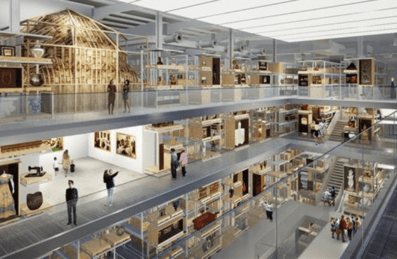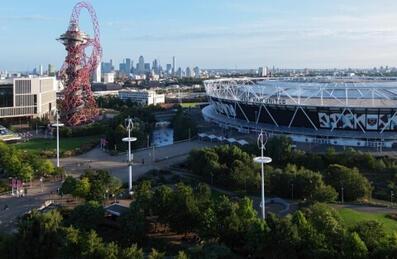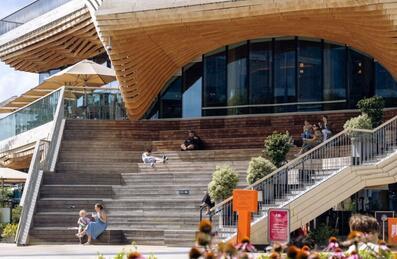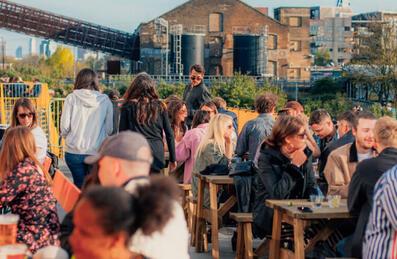
Popular Searches:
Keep up to date
Sign up today for exclusive offers and incredible experiences you won’t want to miss at Queen Elizabeth Olympic Park.
Sign up nowMayor welcomes £141m from Government to support world leading culture & education quarter on the Park
Mayor welcomes £141m from Government to support world leading culture & education quarter on the Park
Press Release 02/12/2014
• University College London and University of the Arts London to create two new campuses • Victoria and Albert Museum and Sadler’s Wells will be at the core of the cultural district
The Mayor of London, Boris Johnson today (2 December) welcomed the Government’s commitment of £141m to create a major new higher education and cultural district on Queen Elizabeth Olympic Park.
It was confirmed today in the Government’s National Infrastructure Plan, that £141m will be committed to help deliver the Mayor’s ‘Olympicopolis’ vision. This will create a world class education and cultural district on Queen Elizabeth Olympic Park bringing together outstanding organisations to showcase exceptional art, dance, history, craft, science, technology and cutting edge design.
University College London (UCL) will create a new university campus to the south of the ArcelorMittal Orbit. The University of the Arts London will establish a new campus on Stratford Waterfront opposite the Aquatics Centre. The Waterfront site will also house new locations for the Victoria and Albert Museum and Sadler’s Wells.
The scheme is expected to deliver 3,000 jobs, 1.5 million additional visitors and £2.8 billion of economic value to Stratford and the surrounding area.
In July the Mayor announced an international design competition for the single education and cultural district on Stratford Waterfront. This had more than 1,000 architects, master planners, place makers, engineers and landscape designers from across the globe register their interest. A shortlist will be announced soon.
Mayor of London, Boris Johnson, said: “Olympicopolis will create a world class centre for arts and education on Queen Elizabeth Olympic Park, which will generate millions of pounds for East London’s economy and support thousands of jobs. It is absolutely fantastic that the Government has confirmed funding for this ambitious project to the tune of £141m, enabling us to progress with detailed plans for its delivery. This is an important milestone in our plans to realise a legacy from London’s 2012 Games that reaps economic and social dividends to last for generations to come.
Vice-Provost (Enterprise & London) at UCL, Professor Stephen Caddick, said: “UCL East represents the largest ever single expansion of UCL since the university was founded nearly 200 years ago. Our new site will be a beacon of how universities should work in decades to come – outward looking, connected to the local community and providing facilities to businesses to work on site to bring new discoveries and inventions out of the lab and into the marketplace.
“Our plans are designed to make a real and practical difference to the lives of people in Newham and London more widely, as well as making a genuine contribution to growth and jobs. London can be the global capital for higher education and we see this development – alongside many others in London – as being an important step in that direction.”
Vice-Chancellor of University of the Arts London, Nigel Carrington, said: “Research on global challenges is increasingly beginning to emerge from the borders of art and science. This new creative approach is physically expressed in the university and cultural quarter at Stratford. The partnership between these four world-class institutions will create radical research, and lead to exciting new technology and fashion businesses in this part of London.”
Director of the V&A, Martin Roth, said: “The education and cultural district planned for the Queen Elizabeth Olympic Park has the potential to be one of the most exciting and important developments of our time. Our aim is to create a new model for museums of the future, where reserve collections and archives are visible and accessible all of the time, and the public can really be engaged with their national collections. We are thrilled that this project has been given support at the highest level and we look forward to continue working with our partners to make it a reality.
Chief Executive and Artistic Director of Sadler’s Wells, Alistair Spalding CBE, said: “We are very excited by the unique opportunity this project offers for collaboration with the V&A, UAL and UCL, amongst the other existing organisations and communities in the neighbouring areas of East London. It allows us to realise a bolder vision for dance; establishing the first venue on this scale specifically designed to serve contemporary choreography. The new space will also significantly enhance our long-held aims of supporting the research, development and making of new work, and nurturing new talent, which is vital for the future of any art form. It is fantastic that the plans for culture and education to be at the heart of the regeneration of the area, can now be realised.”
Mayor of Newham Sir Robin Wales, chair of the Six Growth Boroughs (formerly the Host Boroughs of the 2012 Games), said: “This new cultural hub further cements Newham’s investment in the former Olympic Stadium as a lasting legacy for our residents, London and the nation. As well as offering a huge number of jobs for local people, it will offer a significant boost to East London's economy for years to come. The educational potential of the ‘Olympicopolis’ project will inspire our young people to look at the wider opportunities available to them.”
Chief Executive of the London Legacy Development Corporation, David Goldstone, said: “Today’s announcement is great news for Queen Elizabeth Olympic Park and is a significant endorsement of the work of the Legacy Corporation. We now have a huge amount of work to do to deliver the Mayor’s vision and along with our partners make this project a reality.”
Education
UCL East will provide 125,000m2of space. The first phase of 50,000 m2 will bring together expertise across disciplines, with the aim of forging new connections between researchers and business; fostering radical innovation, new insights and new industries. They will include the UCL Generator the university’s first School of Design. A UCL Museum of the Future, a reinvention of the university museum for the 21st century, the UCL Centre for Experimental Engineering, which will be established to address the acute skills shortage in engineering and develop new approaches to experiential learning in engineering, alongside prototyping and manufacturing facilities. UCL Innovation will focus on technology and UCL Living will comprise living space for undergraduates, postgraduate research students, as well as early career academic staff.
UAL’s 32,000m2 site will create a research and education hub for the global fashion industry, near the traditional heart of the East End fashion trade. It will bring together London College of Fashion’s 6,500 students and staff for the first time in the college’s 100 year history. The new campus will include two major research centres focusing on sustainability and innovation in the fashion industry. It will provide widespread access to advanced fashion technology, business incubators, and a changing programme of public exhibitions.
Culture
V&A E20 will occupy 20,000m2 and will present the museum's outstanding collections in never-before-seen ways, greatly enhancing access to 1000 years of design, architecture, art and performance and encouraging public participation in almost every aspect of museum activities. Permanent galleries on site will include the first dedicated museum space in the UK to document the full breadth of digital design and begin to write the design history of that fast moving field. There will be space for a rolling exhibition programme curated by the V&A with international partners, as well as studio spaces for new and emerging practitioners.
Sadler’s Wells aims to create a 7,000m2 venue with a 600 seat dance theatre to complement its existing venues cementing London’s position as one of the world’s greatest centres for dance. The new venue will provide flexible ‘making’ spaces for research and development and producing new work, facilities for a Choreographic School, and for a Hip Hop Academy.
-Ends-






